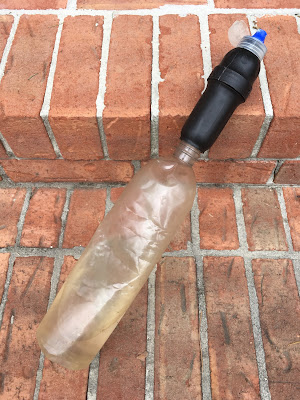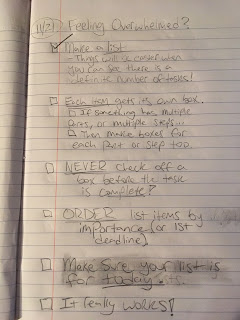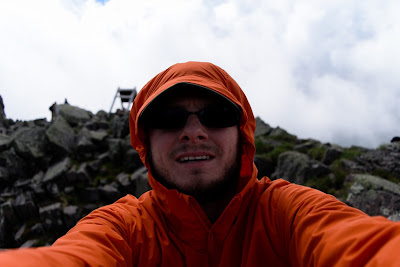I threw my water filter in the trash - why it broke and what you should know about treating your water on a hike
I killed my water filter.
It looks fine, right? One of the worst problems with any screw-on water filter like this one is that you aren't necessarily going to be able to tell that it is broken. Obviously if the filter is visibly damaged, then you know that it probably isn't safe to use. Otherwise, water passes through the filter whether it is broken or not. How does a filter break and what do you do when your water filter breaks on trail?
How does a water filter break?
Impacts
The filter medium itself, whether ceramic, plastic, or otherwise is at risk of breaking with hard impacts to the body of the filter. The common 'micro-tubule' filter medium is inherently delicate in its construction. Depending on the materials used, a drop from chest height on to a rock is probably not going to kill your filter. Keeping in mind the potential for breakage from dropping, in the field I'd say you'll know when the impact is hard enough when you see it.
I've dropped my filter, with full bottle attached a couple of times onto hard surfaces and I've never been worried about it. As an example of an extreme case, I would absolutely trash a filter that had been run over in a parking lot no matter how well it appeared to have survived the ordeal.
Freezing
This is how I broke my filter. Or at least why I assume that my filter is broken.
I took my filter on a trip to see a close trail buddy in Knoxville a couple of weeks ago in case we managed to get out for an overnighter. We didn't end up going out, but my filter came in handy anyway since the tap water at his apartment was absolutely terrible.
After my trip I ended up leaving my water bottle and filter in the back of my car until yesterday. Now, I haven't kept track of all the freezing weather but I'm certain that we have had freezing weather in Chattanooga at least once since I came back from my trip.
And here come the rationalizations:
- "Well, I'm not SURE that there has been freezing weather since then"
- "Maybe it did freeze, but it probably didn't get cold enough inside my car for the filter to freeze"
- "Another filter is going to cost me 40 bucks! Maybe it'll be okay."
If there's any chance that a water filter has been exposed to freezing conditions, it should be thought of as having been destroyed. (If your gear fails on trail pack it out! It will fit in your trash bag and pack with everything else just fine).
If you are wondering just how destructive freezing conditions can be for your water filter, watch this video I found. That is a strong glass bottle. Freezing water expands dramatically, and even the smallest amount of water left over in your filter will cause damage.
With the freezing problem in mind, why would you use a filter in freezing conditions? The main benefit of filters is that they don't really 'run out'. When using chemical treatments on a longer hike it is necessary to restock on water treatment fairly frequently. Chemical treatments also come with a waiting period before the water is safe to drink. With a filter, I can drink freely and often without having to worry about using up my "supply" of clean water. In freezing conditions I've found it best to filter my drinking water into my clean bottle and then immediately return my filter to a clothing pocket against my body where it won't freeze.
In spite of the benefits of filtering, in constantly freezing weather a generous supply of chemical treatment will probably be more reliable and worry-free.
Clogging
Plain old neglect will slowly destroy even the hardiest of equipment items. Failing to back-flush a filter, or failure to replace filter cartridges (a type of filter that I do not recommend), will result in your filter slowly losing flow-rate until you get no more than a trickle of clean water from it in the field. Some filters clog much faster than others, but frequent back-flushing will ensure that your filter does not fail you need it. A well maintained filter can be back-flushed in the field with relative ease where a dedicated syringe or bottle-nozzle is carried. When you are in towns on a long hike, or have come home from your hiking trip, using a faucet can make back-flushing your filter much easier.
I back flush my filter at least every couple of days when I am in town, but give it extra attention whenever I feel that the flow-rate has diminished.
At a minimum, you want to back-flush your filter until the water coming through runs clear.
Backup
Water treatment is one category of equipment in which redundancy is to be celebrated. Carrying extra parts that are easy to lose, like the O-rings that seal the connection between my filter and water bottle, is among the best of ideas I've ever had. If your filter fails, how are you going to get to town or back to the trail head if you are a few days out? In hot weather, you wouldn't even have to spend much time trying to go without water to get yourself into serious trouble.
My water treatment backup is a number of foil-packaged treatment tablets that each provide me with one liter of clean water. These tablets work well with my two water bottles, which both seal up and hold a liter of water. Matching the size of my containers to the treatment strength and instructions on the packaging means that I don't have to do any math or real thinking to get my water treatment right.
If you don't have a water treatment backup, you are alone, and have any serious distance to travel or dangerously hot weather to deal with you MUST continue to drink from available water sources. Assume at this point that you will get sick. Drink from the best possible sources available to you until you are able to get to some measure of safety such a generous person's treatment equipment or a resupply point.
Unfortunately
Unfortunately I am going to have to replace my filter. It just isn't worth the risk of getting sick from some of the nasty things untreated water can have in it (namely Giardia, you don't want Giardia.)
At least a replacement should only cost me 30-40 bucks. What's kind of neat is that the sales of my hiking gear guide will cover the cost of the replacement.
Shameless plug for my equipment guide book, but then again this is my website after all. (you can read it for free with a free trial of kindle unlimited.)





Comments
Post a Comment
Hey, I appreciate you taking the time to comment. I hope you have a really good day.